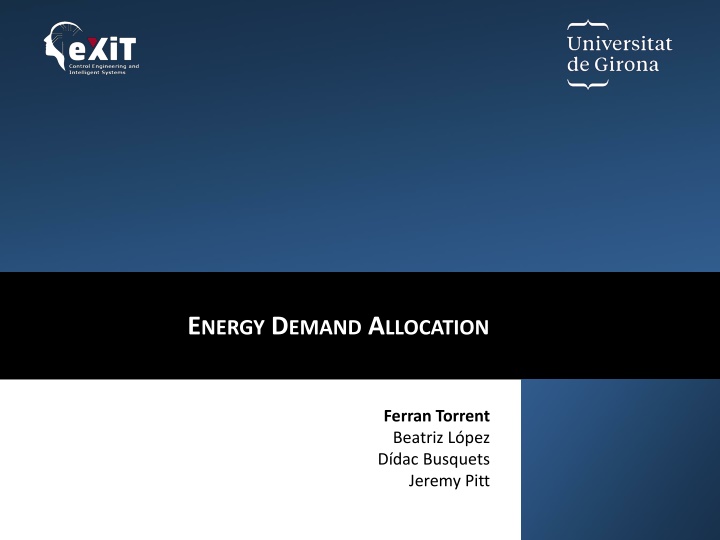
Energy Demand Allocation and Management Methods in Distributed Energy Resources
Explore the challenges and solutions in allocating energy demand for Distributed Energy Resources (DERs) through methods like VPPs and microgrid management. Learn about self-organization, distributive justice, and methodology for efficient energy production and allocation.
Download Presentation

Please find below an Image/Link to download the presentation.
The content on the website is provided AS IS for your information and personal use only. It may not be sold, licensed, or shared on other websites without obtaining consent from the author. If you encounter any issues during the download, it is possible that the publisher has removed the file from their server.
You are allowed to download the files provided on this website for personal or commercial use, subject to the condition that they are used lawfully. All files are the property of their respective owners.
The content on the website is provided AS IS for your information and personal use only. It may not be sold, licensed, or shared on other websites without obtaining consent from the author.
E N D
Presentation Transcript
ENERGY DEMAND ALLOCATION Ferran Torrent Beatriz L pez D dac Busquets Jeremy Pitt
Motivation Increase of Distributed Energy Resources (DERs) Complexity for integrating DG into the labyrinthine distribution system Aggregate and locally control DERs: VPPs, microgrids Need of local management methods April 4, 2025 2/13
Constraints DERs have generation limits ???? + 1 = max ?? ???? + 1 = min ?? ???,??? ?? ???,?? ? ?? ????????? + ?? ? ?? DERs production demand must be within l mits ???? ??? ?? ???? ?? Allocated energy production must meet energy consumption (load) ??? =? ? ? Allocated energy production, cannot exceed DERs capacities ???? ??? ?? ???? ?? Grid constraints April 4, 2025 3/13
Energy demand allocation Determine the amount of energy each DER has to produce in a VPP or microgrid Micro-grid management Centralised management Decentralised management DERs owned by the same organisation Multi-agent (i.e. auctions) Self-organisation Literature April 4, 2025 4/13
Self-organisation & Distributive justice Self-organisation (Ostrom s principles): 1. Clearly defined boundaries 2. Congruence between appropriation and provision rules 3. Effective monitoring 4. Graduated sanctions 5. Fast & cheap conflict-resolution mechanisms 6. Absence of external interferences 7. Nested institutions Distributive justice (Rescher s canons): Canons Implemented functions Implementation through 1. 2. 3. 4. 5. 6. 7. Canon of equity: Canon of needs: Canon of productivity: Canon of effort: Canon of social utility: Canon of supply & demand: Canon of ability allocations, rounds with allocation and payments satisfaction production success rate active time as member CO2emissions capacity of generation when others cannot voting functions Abstract game [Pitt et al., 2012] April 4, 2025 5/13
Methodology ????(?) ?(?) ????(?) Canons rank DERs (using functions weights) Distributive justice (Ranking done using functions weights) ???? and then allocate Scarcity of load ? ? < ? ? : first meet ?? until ??? = ??? or until the load is covered ??? = min ?? ? ,??? ?? ???? Allocation through ranking ? ? = ? ? : ??? = ??? for all DERs Excess of load ? ? > ? ? : first meet ?? until ??? = ?? ??? = min ?? ? ,?? ? and then allocate ???? or the load is covered (reverse order) ???? ??? DERs vote canons (update of the weights) Self-organisation April 4, 2025 6/13
Experimentation Allocation methods: Self-organisation (SO): optimise all canons of justice Centralised equity (?1?): optimising equity between DERs Centralised productivity (?3): optimising production success rate Two VPP configurations: Case 1 Case 2 Combined heat & power 2 of 2MW 1 of 20MW Photovoltaic 2 of 2MW 4 of 2MW Wind turbine 2 of 2MW 2 of 2MW Battery 2 of 2MW 4 of 2MW Renewable DERs have associated a production error Presence of external interferences percentage of green energy (? = 0%, ? = 50%, ? = 75%) Command of prioritising a April 4, 2025 7/13
DERs benefits Case 2 (one big generator) Case 1 (equal size generators) equity productivity SO productivity equity SO Utility productivity SO equity productivity equity SO Gini index Gini index April 4, 2025 8/13
DERs satisfaction Case 2 (one big generator) Case 1 (equal size generators) productivity equity SO equity productivity SO SO productivity equity equity SO productivity Gini index Gini index April 4, 2025 9/13
Reliability and CO2emissions Reliability favours non green DERs The use of green DERs involves prediction errors. Productivity (?3) obtains the best results The use of green DERs reduces CO2emissions Trade-off between reliability, CO2emissions and equity Carbon emissions Uncovered demand equity productivity equity productivity equity productivity equity productivity SO SO SO SO April 4, 2025 10/13
Evolution of canons weights Supply & demand (?6) is the preferred function. It promotes DERs that can produce energy when the others cannot Balance between equity, productivity and diversity Minimisation of the interferences Functions weights Adaptable to new situations Robust against interferences April 4, 2025 11/13
Publications F. Torrent-Fontbona, B. L pez, D. Busquets, J. Pitt. Self-organising energy demand allocation through canons of distributive justice in a microgrid. Engineering Applications of Artificial Intelligence, 52:108- 118, 2016. F. Torrent-Fontbona. Optimisation methods meet the smart grid. New methods for solving location and allocation problems under the smart grid paradigm. PhD Thesis, University of Girona, 2015. Pitt, J., Schaumeier, J., Busquets, D., Macbeth, S., 2012. Self-organising common-pool resource allocation and canons of distributive justice. In: 2012 IEEE Sixth International Conference on Self-Adaptive and Self- Organizing Systems, pp. 119 128 April 4, 2025 12/13
